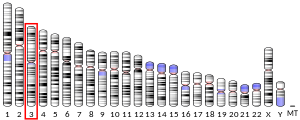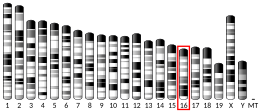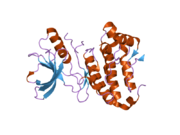EPH 수용체 A3
EPH receptor A3EPH 수용체 A3(에프린 타입-A 수용체 3)은 인간에서 EPHA3 유전자에 의해 인코딩되는 단백질이다.[5][6][7]
함수
이 유전자는 단백질-티로신키나아제 계열의 에프린 수용체 하위군에 속한다.EPH 및 EPH 관련 수용체는 특히 신경계통의 발달 사건을 매개하는 데 관여되어 왔다.EPH 하위 계열의 수용체들은 전형적으로 단일 키나제 영역을 가지고 있으며, 체스가 풍부한 도메인과 2개의 섬유질 타입 III를 포함하는 세포외 영역을 가지고 있다.에프린 수용체는 세포외 영역 시퀀스의 유사성과 에프린-A와 에프린-B 리간드를 결합하는 친화력을 바탕으로 2개 그룹으로 나뉜다.이 유전자는 에프린-A 리간드를 결합하는 단백질을 암호화한다.이 유전자에 대해 두 개의 다른 분할된 대본 변형이 설명되었다.[7]
상호작용
EPH 수용체 A3은 EFNB2[8][9] 및 EFNA5와 상호작용하는 것으로 나타났다.[9][10]
참조
- ^ a b c GRCh38: 앙상블 릴리스 89: ENSG000044524 - 앙상블, 2017년 5월
- ^ a b c GRCm38: 앙상블 릴리스 89: ENSMUSG000052504 - 앙상블, 2017년 5월
- ^ "Human PubMed Reference:". National Center for Biotechnology Information, U.S. National Library of Medicine.
- ^ "Mouse PubMed Reference:". National Center for Biotechnology Information, U.S. National Library of Medicine.
- ^ Boyd AW, Ward LD, Wicks IP, Simpson RJ, Salvaris E, Wilks A, Welch K, Loudovaris M, Rockman S, Busmanis I (March 1992). "Isolation and characterization of a novel receptor-type protein tyrosine kinase (hek) from a human pre-B cell line". J Biol Chem. 267 (5): 3262–7. doi:10.1016/S0021-9258(19)50725-6. PMID 1737782.
- ^ Wicks IP, Wilkinson D, Salvaris E, Boyd AW (April 1992). "Molecular cloning of HEK, the gene encoding a receptor tyrosine kinase expressed by human lymphoid tumor cell lines". Proc Natl Acad Sci U S A. 89 (5): 1611–5. doi:10.1073/pnas.89.5.1611. PMC 48502. PMID 1311845.
- ^ a b "Entrez Gene: EPHA3 EPH receptor A3".
- ^ Cerretti DP, Vanden Bos T, Nelson N, Kozlosky CJ, Reddy P, Maraskovsky E, Park LS, Lyman SD, Copeland NG, Gilbert DJ (November 1995). "Isolation of LERK-5: a ligand of the eph-related receptor tyrosine kinases". Mol. Immunol. 32 (16): 1197–205. doi:10.1016/0161-5890(95)00108-5. PMID 8559144.
- ^ a b Lackmann M, Mann RJ, Kravets L, Smith FM, Bucci TA, Maxwell KF, Howlett GJ, Olsson JE, Vanden Bos T, Cerretti DP, Boyd AW (June 1997). "Ligand for EPH-related kinase (LERK) 7 is the preferred high affinity ligand for the HEK receptor". J. Biol. Chem. 272 (26): 16521–30. doi:10.1074/jbc.272.26.16521. PMID 9195962.
- ^ Kozlosky CJ, VandenBos T, Park L, Cerretti DP, Carpenter MK (August 1997). "LERK-7: a ligand of the Eph-related kinases is developmentally regulated in the brain". Cytokine. 9 (8): 540–9. doi:10.1006/cyto.1997.0199. PMID 9245480.
추가 읽기
- Flanagan JG, Vanderhaeghen P (1998). "The ephrins and Eph receptors in neural development". Annu. Rev. Neurosci. 21: 309–45. doi:10.1146/annurev.neuro.21.1.309. PMID 9530499.
- Zhou R (1998). "The Eph family receptors and ligands". Pharmacol. Ther. 77 (3): 151–81. doi:10.1016/S0163-7258(97)00112-5. PMID 9576626.
- Ernst AF, Jurney WM, McLoon SC (1999). "Mechanisms involved in development of retinotectal connections: roles of Eph receptor tyrosine kinases, NMDA receptors and nitric oxide". Prog. Brain Res. 118: 115–31. doi:10.1016/S0079-6123(08)63204-5. PMID 9932438.
- Holder N, Klein R (1999). "Eph receptors and ephrins: effectors of morphogenesis". Development. 126 (10): 2033–44. doi:10.1242/dev.126.10.2033. PMID 10207129.
- Wilkinson DG (2000). "Eph receptors and ephrins: regulators of guidance and assembly". Int. Rev. Cytol. International Review of Cytology. 196: 177–244. doi:10.1016/S0074-7696(00)96005-4. ISBN 9780123646002. PMID 10730216.
- Xu Q, Mellitzer G, Wilkinson DG (2001). "Roles of Eph receptors and ephrins in segmental patterning". Philos. Trans. R. Soc. Lond. B Biol. Sci. 355 (1399): 993–1002. doi:10.1098/rstb.2000.0635. PMC 1692797. PMID 11128993.
- Wilkinson DG (2001). "Multiple roles of EPH receptors and ephrins in neural development". Nat. Rev. Neurosci. 2 (3): 155–64. doi:10.1038/35058515. PMID 11256076. S2CID 205014301.
- Beckmann MP, Cerretti DP, Baum P, Vanden Bos T, James L, Farrah T, Kozlosky C, Hollingsworth T, Shilling H, Maraskovsky E (1994). "Molecular characterization of a family of ligands for eph-related tyrosine kinase receptors". EMBO J. 13 (16): 3757–62. doi:10.1002/j.1460-2075.1994.tb06685.x. PMC 395287. PMID 8070404.
- Wicks IP, Lapsys NM, Baker E, Campbell LJ, Boyd AW, Sutherland GR (1994). "Localization of a human receptor tyrosine kinase (ETK1) to chromosome region 3p11.2". Genomics. 19 (1): 38–41. doi:10.1006/geno.1994.1009. PMID 8188238.
- Cerretti DP, Vanden Bos T, Nelson N, Kozlosky CJ, Reddy P, Maraskovsky E, Park LS, Lyman SD, Copeland NG, Gilbert DJ (1996). "Isolation of LERK-5: a ligand of the eph-related receptor tyrosine kinases". Mol. Immunol. 32 (16): 1197–205. doi:10.1016/0161-5890(95)00108-5. PMID 8559144.
- Lackmann M, Mann RJ, Kravets L, Smith FM, Bucci TA, Maxwell KF, Howlett GJ, Olsson JE, Vanden Bos T, Cerretti DP, Boyd AW (1997). "Ligand for EPH-related kinase (LERK) 7 is the preferred high affinity ligand for the HEK receptor". J. Biol. Chem. 272 (26): 16521–30. doi:10.1074/jbc.272.26.16521. PMID 9195962.
- Kozlosky CJ, VandenBos T, Park L, Cerretti DP, Carpenter MK (1997). "LERK-7: a ligand of the Eph-related kinases is developmentally regulated in the brain". Cytokine. 9 (8): 540–9. doi:10.1006/cyto.1997.0199. PMID 9245480.
- Ephnomenclaturecommittee (1997). "Unified nomenclature for Eph family receptors and their ligands, the ephrins. Eph Nomenclature Committee". Cell. 90 (3): 403–4. doi:10.1016/S0092-8674(00)80500-0. PMID 9267020. S2CID 26773768.
- Lackmann M, Oates AC, Dottori M, Smith FM, Do C, Power M, Kravets L, Boyd AW (1998). "Distinct subdomains of the EphA3 receptor mediate ligand binding and receptor dimerization". J. Biol. Chem. 273 (32): 20228–37. doi:10.1074/jbc.273.32.20228. PMID 9685371.
- Ciossek T, Monschau B, Kremoser C, Löschinger J, Lang S, Müller BK, Bonhoeffer F, Drescher U (1998). "Eph receptor-ligand interactions are necessary for guidance of retinal ganglion cell axons in vitro". Eur. J. Neurosci. 10 (5): 1574–80. doi:10.1046/j.1460-9568.1998.00180.x. PMID 9751130. S2CID 20470923.











